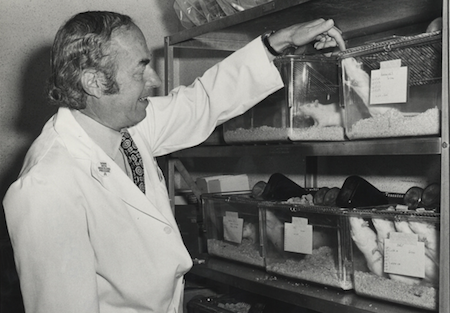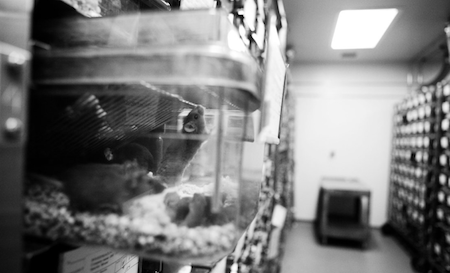
Laboratory rats, 1974
Pondering The Impending Meaningless Deaths of Lab Animals, James Fallows writes:
- Under shutdown rules, the animals still get food and water and are kept alive. But because most researchers are forbidden to work with them, the crucial moments for tests and measurements may pass; experimental conditions may change; and in other ways projects that had been months or years in preparation may be interrupted or completely ruined. Yes, I realize that lab animals’ situation is precarious in the best of circumstances. But their lives and deaths have more purpose as part of biomedical discovery than in their current pointless captivity.
NPR’s John Hamilton checks into what it takes to maintain the lab mice without the research staff, the cost of lost research and how to euthanize animals who cannot be maintained.
- The loss of so-called transgenic mice, many of which have genes that cause them to develop versions of human diseases, is especially troubling, scientists say. A single animal can cost thousands of dollars to replace, they say. And some cannot be replaced at any cost.
The US government shut down on Monday, September 30, 2013. From the first day, Government Shutdown Halts Scientific Research Projects Across The Country. Only minimal staffing was allowed to keep on working. Some scientists were not allowed access to their labs even if they wanted to keep their research going without pay. And some were instructed not to talk to the media. But the consequences of being unable to keep the animals in research labs alive weighed heavily on all. On Oct.3, Wired quoted an anonymous scientist:
- I don’t think the public realizes the devastating impact that this has on scientific research. Scientific research is not like turning on and off an assembly line. Experiments are frequently long-term and complicated. They involve specific treatments and specific times. You can’t just stop and restart it. You’ve probably just destroyed the experiment.
You also can’t necessarily recover. You can’t begin an experiment all over again. If you do, you’ll be set back months — if there’s even time and personnel to do it. But often, science moves rapidly, times change, and you can’t re-initiate the experiments. It’s an enormous loss to scientific research, an enormous loss of time and personnel.
It’s not a matter of feeding the animals and cleaning their cages. These animals used for research are used in intricate experiments, involving treatments and collection of data performed by hundreds of individual scientists with each project. An animal caretaker can’t continue that.
It’s almost two weeks later, Sunday, October 13, 2013. US government is still shut down. I keep checking the headlines for Monday updates.
Notes:
Dream Horse Ranch animal news on Facebook.



